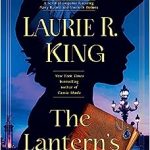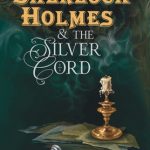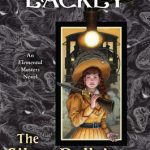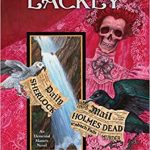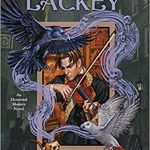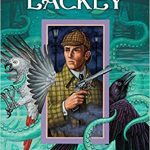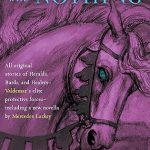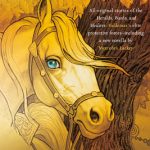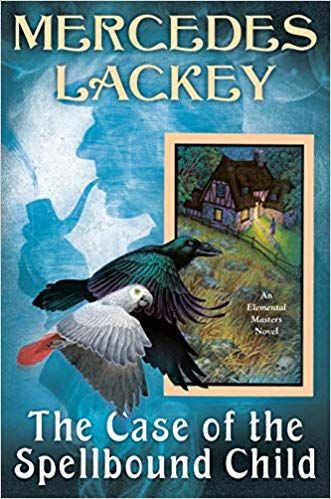 The Case of the Spellbound Child (Elemental Masters, #14) by Mercedes Lackey
The Case of the Spellbound Child (Elemental Masters, #14) by Mercedes Lackey Format: eARC
Source: supplied by publisher via NetGalley
Formats available: hardcover, paperback, ebook
Genres: historical fantasy
Series: Elemental Masters #14
Pages: 320
Published by DAW Books on December 3, 2019
Purchasing Info: Author's Website, Publisher's Website, Amazon, Barnes & Noble, Kobo, Bookshop.org
Goodreads
The fourteenth novel in the magical alternate history Elemental Masters series continues the reimagined adventures of Sherlock Holmes in a richly-detailed alternate 20th-century England.
While Sherlock is still officially dead, John and Mary Watson and Nan Killian and Sarah Lyon-White are taking up some of his case-load--and some for Lord Alderscroft, the Wizard of London.
Lord Alderscroft asks them to go to Dartmoor to track down a rumor of evil magic brewing there. Not more than four hours later, a poor cottager, also from Dartmoor, arrives seeking their help. His wife, in a fit of rage over the children spilling and spoiling their only food for dinner that night, sent them out on the moors to forage for something to eat. This is not the first time she has done this, and the children are moor-wise and unlikely to get into difficulties. But this time they did not come back, and in fact, their tracks abruptly stopped "as if them Pharisees took'd 'em." The man begs them to come help.
They would have said no, but there's the assignment for Alderscroft. Why not kill two birds with one stone?
But the deadly bogs are not the only mires on Dartmoor.
My Review:
I actually read this a couple of weeks ago, while I was in the middle of listening to The Sinister Mystery of the Mesmerizing Girl followed by Mycroft and Sherlock: The Empty Birdcage. I was on a Sherlock Holmes kick and looking for stories that were at least Holmes-adjacent, as both Mesmerizing Girl and Spellbound Child turned out to be.
In other words, unlike Mycroft and Sherlock, which is definitely Holmesian all the way even if it is still focused more on the older brother than the younger, both the Extraordinary Adventures of the Athena Club and the Elemental Masters are series that I got into for Holmes but stayed in for everybody else.
Which is a good thing, because Spellbound Child, like last month’s Mesmerizing Girl, is all about the everybody else and only tangentially about Holmes. At least in Spellbound Child Sherlock isn’t in need of rescue along with some of that everybody else.
This story is part of the author’s Elemental Masters series. In this series, the world is an alternate version of our own history, it’s just a version in which magic works but is mostly hidden and strictly controlled by its practitioners – especially those who are masters of their particular elements.
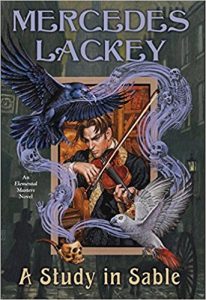 The series began with The Fire Rose back in 1995 – a story that I read at the time but have no recollection of beyond the concept. I kept up with the first few books in the series, but then dropped it for a long time, until A Scandal in Battersea caught my attention two years ago, not for its fantasy but for its screamingly obvious Sherlockian elements. And have continued with the series ever since, even stepping back one book to A Study in Sable, where the entire current cast of characters was introduced.
The series began with The Fire Rose back in 1995 – a story that I read at the time but have no recollection of beyond the concept. I kept up with the first few books in the series, but then dropped it for a long time, until A Scandal in Battersea caught my attention two years ago, not for its fantasy but for its screamingly obvious Sherlockian elements. And have continued with the series ever since, even stepping back one book to A Study in Sable, where the entire current cast of characters was introduced.
The above should give heart to any readers who have not read the whole series. I do think starting with A Study in Sable would be beneficial to becoming acquainted with the current cast and situation. And all Holmes pastiche series seem to start with a play on the first Holmes story, A Study in Scarlet, as this one does.
However, Holmes is not an elemental master – at least not unless someone declares logic to be a form of elemental magic. He is, rather, a skeptic. In spite of his friend and biographer, Dr. John Watson, being an elemental master himself, as is Watson’s wife Mary. It is an interesting take on their long-term friendship and collaboration, as Holmes has his sphere in which he is an acknowledged expert, but Watson also has his. And there are times when logic must defer to magic, no matter how much Holmes may scoff. He does not believe, but he has seen. And there have been multiple occasions where magic is the only answer left after he has eliminated the impossible.
This story takes place during Holmes’ hiatus after Reichenbach Falls, so his presence is very much on the QT, as that saying goes. He’s part of the story but neither the integral or central part, and that’s as it should be.
Because this is a case that is intimately steeped in magic. And in a peculiar way, it hearkens back to the original premise of this series, that of retelling fairy tales in a new and magical world.
The child who is missing, and spellbound, turns out to be a surprisingly rational and logical version of Gretel. Making her also missing, also spellbound, but ot nearly as mature or rational or logical little brother Hansel. (This is a series where the females often get top billing and solve the case – and so it proves here.)
It is up to non-magical but highly practical Gretel, really Helen Byerly, to figure out just how the extremely wicked witch was ensorcelling ALL the children, and escape to find help. Help in the form of Dr. John Watson, his wife Mary, Spirit Master Sarah Lyon-White and psychic Nan Killian, along with their foster daughter Suki and their highly intelligent birds Grey and Neville, sent to the “wilds” of Dartmoor by the Wizard of London to determine why so many children have gone missing in recent years – and why so little is being done about it.
While this case doesn’t wind up at Baskerville Hall – as I fully admit I was more than half expecting – it has every bit as as many twists, turns and surprises as Holmes’ and Watson’s more famous visit to the moor.
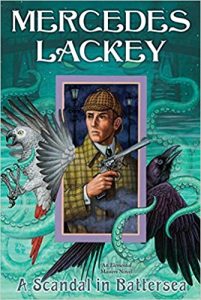 Escape Rating B+: If you look carefully at the background image in the book cover, you’ll recognize the silhouette of the famous detective, complete with pipe and just the suggestion of a deerstalker cap. It does lead one to believe that there will be more of Holmes than actually occurs in this case. On the other hand, there’s plenty of Watson, or rather, Watsons in this one, as the Wizard of London has tasked the Watsons with a case that he finds more important than the locals seem to.
Escape Rating B+: If you look carefully at the background image in the book cover, you’ll recognize the silhouette of the famous detective, complete with pipe and just the suggestion of a deerstalker cap. It does lead one to believe that there will be more of Holmes than actually occurs in this case. On the other hand, there’s plenty of Watson, or rather, Watsons in this one, as the Wizard of London has tasked the Watsons with a case that he finds more important than the locals seem to.
After all, it’s obvious to him fairly early on that someone is kidnapping children with magical talent. While all that the locals notice is that the missing children are “not their kind” meaning either poor or members of the Travelers, and are therefore beneath society’s notice.
Everyone involved, the Watsons, Nan and Sarah, as well as Holmes (and the reader) are fairly incensed by that attitude and determined to do what they can to get to the bottom of it.
I found the case to be an intriguing one, as the perspective switches from the imprisoned children to the search for them and back again. In spite of the magic involved, the search is actually fairly straightforward, even if some of the means and methods are otherworldly. What tugs at the heart in this story is the plight of those children, trapped by chains of both metal and fear to serve as magical “batteries” for a hedge wizard who would be a bully with or without magic.
The character who really shines in this story is the non-magical but eminently practical and oh-so-brave Helen Byerly. She’s trapped with the others, chained by magic she doesn’t understand, and yet she still finds a way to improve conditions for everyone she takes under her care – and reasons her way to an escape that has a chance of freeing them all. The story may focus on the Watsons and the other masters and magic users, but Helen is the real hero of the tale.
And I always love seeing a smart girl participate in her own rescue!






